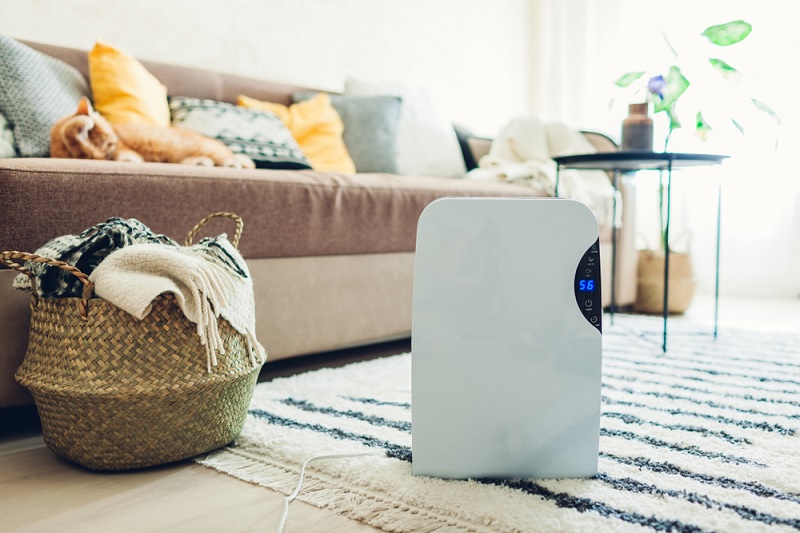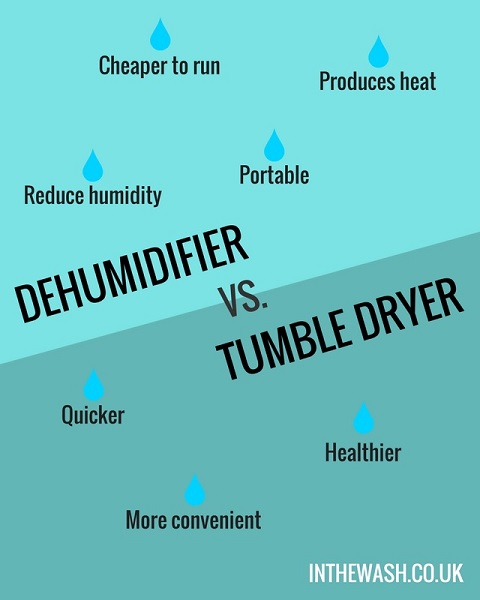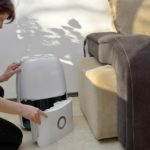The main purpose of a dehumidifier is to reduce the level of humidity in the air, which is why people often use them to tackle damp and prevent related problems such as mould.
One surprising thing about dehumidifiers is that they can be very effective at drying clothes, which is why some people use a dehumidifier rather than a tumble dryer.
Drying clothes indoors can be bad for your health, as it raises the humidity level and exacerbates problems such as asthma and allergies. If you have no option but to dry clothes indoors though, using a dehumidifier will make the process healthier and quicker.
Many dehumidifiers come with a laundry function for the purpose of drying your washing quickly. When on laundry mode, the dehumidifier will have usually more airflow and will keep running at full power rather than switching itself off after a while.
For the best results, position your dehumidifier underneath or next to a clothes horse/drying rack in a small room.
If you’re interested in using a dehumidifier to dry your clothes, read the reviews below of what we consider to be the best options available in the UK.
Best Dehumidifiers for Drying Clothes in the UK
1. Pro Breeze PB-06-AE 12L Dehumidifier
Features:
- Quiet Mark certified, so it’s quieter than average
- 12 litres a day water extraction rate
- 8L water tank
- Auto shut off
- Dimensions: 49.5L x 28.5W x 24H cm
- Built in humidity sensor
Performance
At a rate of 12 litres per day, the Pro Breeze is an exceptional device for removing moisture in your house. Clothes are dried in a matter of short hours without using an enormous volume of electricity.
Using the digital display, you can easily control the level of humidity in your household, as well as set up to 24-hour timers to turn it on or off at any time of the day. Whilst it’s a great product, the price can be somewhat discouraging for those with lower budgets.
2. EcoAir DD122 Simple Desiccant Dehumidifier
Features:
- Laundry mode
- Economy and Turbo modes
- Handle for portability
- Timer
- 7 litres a day water extraction rate
- 2-litre water tank
- 2-year manufacturer’s warranty
- Power: 580 watts
- Dimensions: 48.5 x 29 x 17.5 cm
Performance
As you might have guessed from the word ‘desiccant’ in the name, this dehumidifier is very good at drying things out, including laundry. It has a special laundry mode which makes the dehumidifier work continuously, drying your clothes out within 2-4 hours.
As well as drying your laundry, the EcoAir DD122 Simple Desiccant Dehumidifier is also good at reducing condensation, preventing the formation of mould and easing allergy symptoms. It’s a great gadget to have in your home over the winter months.
3. Meaco 12L Platinum Dehumidifier
Features:
- Can be used with a HEPA filter for cleaning the air
- Carrying handle for portability
- Timer
- Humidistat
- Child lock
- 28 litres a day water extraction rate
- 5-litre water tank
- 2-year manufacturer’s warranty
- Power: 165 watts
- Dimensions: 48.5 x 32.5 x 24.8 cm
Performance
This dehumidifier has a low-energy design, so it’s relatively cheap to run. It’s also fairly quiet, so it’s unlikely to disturb you if you use it to dry your laundry overnight.
The Meaco 12L Platinum Dehumidifier is quite compact and has a carrying handle so you can move it around easily. It’s a good choice for drying clothes indoors in the winter, or if you live in a small flat and don’t have outdoor space.
4. Inventor EVA ION PRO Wi-Fi 20L Dehumidifier
Features:
- 20 litre per day extraction rate
- HEPA and activated carbon filters
- Laundry setting with turbo function
- WiFi functionality
- Power: 240 watts
- Dimensions: 24.5 x 35 x 51 cm
Performance
When it comes to finding a dehumidifier for the smart home generation, this Inventor EVA ION is ideal. This dehumidifier can extract 20 litres of moisture a day, and the integrated filters can tackle nasty smells and bacteria floating around in the air.
The EVA ION’s integrated laundry dryer function can make light work of drying clothing, and the turbo mode is handy for those last-minute school uniform emergencies.
This dehumidifier is not only powerful; it’s also fairly quiet too with a noise level of just 37 dB.
5. Aribio 12L/Day Dehumidifier
Features:
- 12 litre per day extraction rate
- Laundry and night modes
- Timer
- Child lock
- Portable and lightweight
- Super quiet at just 36 dB
- Power: 178 watts
- Dimensions: 25.5 x 22 x 46 cm
Performance
Aribio’s dehumidifier can move up to 12 litres of water a day, and has a dedicated laundry mode that will help dry your clothing even in wet, humid weather.
When it comes to drying laundry, this dehumidifier is designed to be kept close to the underneath of the laundry where it can assist gravity in removing the water from clothing.
This handy little dehumidifier is easy to operate, easy to move around your home wherever it is needed and does a great job of drying laundry too.
Drying Clothes with a Dehumidifier
Most of us love to dry our laundry outside when the weather allows, but there are times when this simply isn’t an option. It can be really difficult to get clothes dry in wet or cold weather, and those of us living in flats may not have a suitable outdoor area for drying clothes.
A tumble dryer is an option for some people, however not everyone has enough space, and they can prove costly to run.
Using a dehumidifier is an option you may not have previously thought of for your drying laundry indoors, but there are several benefits of using one.
Dehumidifiers help prevent common problesm with drying clothes indoors
Many of us dry wet clothes directly on radiators or clothes airers when we have no option to dry our clothes outdoors, but this can take a long time and produce a lot of excess moisture in your home – as much as a whole bucket-full of water each time we dry an average wash.
The increased moisture can then in turn be bad for your house and your health, as the water vapour condenses on cold surfaces such as windows and walls, and mildew and mould begins to grow. This is a particular worry for anyone with health problems such as asthma or allergies.
How does a dehumidifier work and what does it do?
The main purpose of a dehumidifier is to reduce the level of humidity in a room. Most dehumidifiers have an internal refrigeration system, which cools the air drawn into the dehumidifier over a coil.
As the air cools, the water vapour condenses on the cold surface of the coil and this is collected in a water container.
Because dehumidifiers reduce the level of moisture in the air, they are excellent at preventing the growth of mildew and mould in the home; however they can also be very effective at drying laundry. A dehumidifier will suck the moisture out of your clothes, reducing drying time.
The recommended indoor humidity is between 40% and 60%, and a dehumidifier will generally aim to maintain a level of around 55%.
Although different types of dehumidifiers work in different ways, the overall process is basically similar. The main difference tends to be the way the moisture is extracted from the air.
All dehumidifiers use a fan to draw moist air in through a grille at the front of the machine. The moisture is then extracted from the air and the dry air is heated, although the method of doing this varies between the different types of machine. The dry and warm air is then expelled using the same fan or a different one.
The moisture extracted from the air is generally dripped into a collecting tank, which needs to be emptied periodically. When the tank is full, the machine shuts off automatically and a warning light is displayed.
Some dehumidifiers have a hose that takes the water directly to a drain, so emptying is never needed.
Dehumidifier Types
Compressor
Dehumidifiers originally had a compressor to help extract moisture, using a similar technique to refrigerators and air conditioning. This type of machine has an array of pipes through which coolant is circulated constantly by the compressor.
The moist air passes over these pipes and, as it cools, the moisture condenses to form water that drips into the tank. The dried air is then passed over a heating element before being expelled through another grille.
Desiccan
Another variation is a desiccant dehumidifier, where the moist air passes over a rotating wheel that has absorbent material similar to the silica gel often found with products that need to be kept dry. This material absorbs the moisture, which is then heated to re-vaporise it before ducting externally.
Thermo-electric
The third option is sometimes described as a thermo-electric dehumidifier, or one that has peltier technology. Here the input fan draws the moist air onto a cold heat sink, where the moisture condenses and drips into the collecting tank. The dried air then passes to a hot heat sink and is then expelled as warm and dry air.
Pros and cons of the different dehumidifier types
Noise
Because the older condenser types use a pump to circulate the coolant and generally have larger fans, they are noisier than the other two types.
The desiccant types have a rotating wheel instead of a compressor and so are quieter, while the peltier types, with few moving parts and often only one small fan, are the quietest of all. If you want something particularly quiet, check out our guide to the quietest dehumidifiers available in the UK.
Throughput
The extra noise level, however, is partly the result of increased throughput, with compressor models on average able to extract 70 pints of water a day, while desiccant versions are capable of 15-20 pints and peltiers only 0.5-1.25 pints.
This can of course vary depending on the size of the machine but does suggest that the latter are suitable only for small areas and compressor types are the main workhorses.
Reliability
Since they have very few moving parts, the peltier models should in theory be the most reliable and the longest lasting.
However, this will depend on the quality of the build, with many being made from cheap components to keep the cost to the customer as low as possible.
The most likely part to fail is the fan. However, in the peltier models at least, this is often a low powered type, the same as used in PCs, and can be replaced easily and cheaply.

How to Dry Your Laundry Using a Dehumidifier
When drying your clothes using a dehumidifier, firstly decide which room to dry them in. It’s usually best to dry your clothes in the smallest room you can.
The smaller the room, the quicker the dehumidifier can dry the air and reduce the humidity, and therefore dry your laundry more quickly and efficiently.
It’s also a good idea to close the door and windows in the room where you’re drying clothes, so that the dehumidifier is only working in the room where the washing is drying and not working on reducing humidity in the rest of your home.
It’s generally not recommended to dry laundry in rooms with a lot of soft furnishings (such as bedrooms) if at all possible.
Once you’ve found the best possible spot for drying your clothes, hang your clothes evenly spaced onto an airer or clothes horse, and place the dehumidifier close by.
Depending on the model of dehumidifier, you may be able direct the air flow from the dehumidifier towards the clothes horse and particularly towards heavier items of laundry.
Many dehumidifiers have a laundry setting, which creates a greater airflow for drying clothes and also prevents humidity level cut off, so it’s always best to use this option if available.
Dehumidifier vs Tumble dryer – Which Is Better for Drying Clothes?
If space isn’t a problem in your home, you may wonder which is the best option for drying laundry – a dehumidifier or a tumble dryer?
Tumble dryers may cost more to run, but they are generally much quicker for drying clothes, and also prevent VOCs (volatile organic compounds) being released into the air during the drying process.
A dehumidifier will costly roughly the same to buy as a budget tumble dryer, but be much cheaper to run and more flexible as you can easily move it around and use it in different rooms.
A dehumidifier will also reduce the humidity in your home, so you are effectively getting two uses from one appliance. Dehumidifiers also produce a small amount of heat, helping to warm your home up and reduce heating bills.
Using a dehumidifier to dry your clothes may also help the appearance and feel of your laundry, and reduce ironing time.
Tumble drying clothes uses heat which can mean clothes feel rough and rigid, and can even shrink them. Drying your laundry with a dehumidifier can result in your clothes feeling much softer.
Both dehumidifiers and tumble dryers have their own advantages, which are summarised below.
Dehumidifier advantages:
- Cheaper to run
- Portable
- Useful for reducing humidity in the home (great if you live in a small flat with little ventilation)
- Produces a small amount of heat, so will help warm your home in the winter
Tumble dryer advantages
- Quicker
- Healthier (no VOCs released from washing into the air)
- More convenient (no drying rack needed)

How Long Does It Take a Dehumidifier to Dry Clothes?
Most dehumidifiers can dry laundry in a few hours, with the average being about 3 to 4 hours. However, this isn’t a fixed number.
Like with anything else in life, exactly how long it takes a dehumidifier to dry clothing depends on a variety of factors, much like if you were tumble drying clothing.
The first factor is the amount of laundry that you are trying to dry. A larger load of washing will have a greater amount of moisture that needs to be removed, which naturally takes longer.
In addition, the size of the room you are using can influence how long the laundry takes to dry. It will take longer for a dehumidifier to dry laundry in a larger room than a smaller one as the dehumidifier has more air to extract moisture from.
In the same way, if the room is too small and air cannot circulate around the laundry, the dehumidifier will struggle.
The ideal position for drying laundry with a dehumidifier would be a small bedroom, bathroom, or a large storage cupboard; as long as you have the room to space out your laundry properly.
The size and power of the dehumidifier is the final factor that will determine how long it will take to dry the laundry.
Smaller units or ones without dedicated laundry modes will still successfully dry your clothing, but will take longer than more powerful units or ones with specialist laundry modes.
It is worth noting, however, that whilst the laundry mode will dry clothing faster, it does tend to use more energy.
Is it Cheaper to Dry Clothes with a Dehumidifier?
On average, it is much cheaper to dry clothing with a dehumidifier than it is with a tumble dryer. A dehumidifier should be much cheaper than using a traditional vented or condenser dryer, but the difference isn’t so big when compared to the most energy-efficient heat pump dryers.
The running costs of a tumble dryer will vary depending on the type. At the time of writing, a vented or condenser tumble dryer is likely to cost around £1.60-£1.70 per cycle to run, whereas a heat pump tumble dryer would only cost about 60p per cycle.
According to Pro Breeze, the Pro Breeze PB-06-AE 12L Dehumidifier featured at the top of this article costs as little as 7p an hour. If it takes four hours to dry your clothes, that would work out at 28p—much cheaper than running a tumble dryer.
Conclusion
If we had to pick just one dehumidifier for drying clothes, it would be the Pro Breeze PB-06-AE 12L Dehumidifier. It’s quiet, easy to use and can extract an impressive 12 litres of moisture a day.

In The Wash is your guide to the best laundry and cleaning products, tips and tricks. Our mission is to solve the UK’s cleaning and laundry dilemmas!



![Meaco 12L Low Energy Dehumidifier and Air Purifier 2 in 1- Quiet Dehumidifier For Flats, Apartments & Small Homes - Controls Humidity & Cleans Air Year Round, Comes with HEPA Filter [Energy Class A] Meaco 12L Low Energy Dehumidifier and Air Purifier 2 in 1- Quiet Dehumidifier For Flats, Apartments & Small Homes - Controls Humidity & Cleans Air Year Round, Comes with HEPA Filter [Energy Class A]](https://m.media-amazon.com/images/I/31o+cz55s8L._SL160_.jpg)







